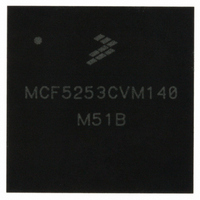MCF5253CVM140 Freescale Semiconductor, MCF5253CVM140 Datasheet - Page 288

MCF5253CVM140
Manufacturer Part Number
MCF5253CVM140
Description
IC MPU 32BIT 140MHZ 225-MAPBGA
Manufacturer
Freescale Semiconductor
Series
MCF525xr
Datasheets
1.MCF5253VM140J.pdf
(34 pages)
2.MCF5253VM140J.pdf
(8 pages)
3.MCF5253VM140J.pdf
(648 pages)
4.MCF5253VM140J.pdf
(2 pages)
Specifications of MCF5253CVM140
Core Processor
Coldfire V2
Core Size
32-Bit
Speed
140MHz
Connectivity
CAN, EBI/EMI, I²C, QSPI, UART/USART, USB OTG
Peripherals
DMA, WDT
Program Memory Type
ROMless
Ram Size
128K x 8
Voltage - Supply (vcc/vdd)
1.08 V ~ 1.32 V
Data Converters
A/D 6x12b
Oscillator Type
External
Operating Temperature
-40°C ~ 85°C
Package / Case
225-MAPBGA
Family Name
MCF5xxx
Device Core
ColdFire V2
Device Core Size
32b
Frequency (max)
140MHz
Instruction Set Architecture
RISC
Supply Voltage 1 (typ)
1.2/3.3V
Operating Supply Voltage (max)
1.32/3.6V
Operating Supply Voltage (min)
1.08/3V
Operating Temp Range
-40C to 85C
Operating Temperature Classification
Industrial
Mounting
Surface Mount
Pin Count
225
Package Type
MA-BGA
Lead Free Status / RoHS Status
Lead free / RoHS Compliant
Number Of I /o
-
Eeprom Size
-
Program Memory Size
-
Lead Free Status / Rohs Status
Compliant
Available stocks
Company
Part Number
Manufacturer
Quantity
Price
Company:
Part Number:
MCF5253CVM140
Manufacturer:
FREESCALE
Quantity:
300
Company:
Part Number:
MCF5253CVM140
Manufacturer:
Freescale Semiconductor
Quantity:
10 000
Part Number:
MCF5253CVM140
Manufacturer:
FREESCALE
Quantity:
20 000
Company:
Part Number:
MCF5253CVM140J
Manufacturer:
Freescale Semiconductor
Quantity:
10 000
- MCF5253VM140J PDF datasheet
- MCF5253VM140J PDF datasheet #2
- MCF5253VM140J PDF datasheet #3
- MCF5253VM140J PDF datasheet #4
- Current page: 288 of 648
- Download datasheet (8Mb)
Queued Serial Peripheral Interface (QSPI) Module
Data transfer is synchronized with the internally generated QSPI_CLK, whose phase and polarity are
controlled by QMR[CPHA] and QMR[CPOL]. These control bits determine which QSPI_CLK edge is
used to drive outgoing data and to latch incoming data.
16.3.2
Baud rate is selected by writing a value from 2 to 255 into QMR[BAUD]. The QSPI uses a prescaler to
derive the QSPI_CLK rate from the system clock, SYSCLK, divided by two.
A baud rate value of zero turns off the QSPI_CLK.
The desired QSPI_CLK baud rate is related to SYSCLK and QMR[BAUD] by the following expression:
QMR[BAUD] = SYSCLK / [2 × (desired QSPI_CLK baud rate)] (SYSCLK = CORE operating
frequency / 2).
16.3.3
The QSPI supports programmable delays for the QSPI_CS signals. The time between QSPI_CS assertion
and the leading QSPI_CLK edge, and the time between the end of one transfer and the beginning of the
next, are both independently programmable.
The chip select to clock delay enable (DSCK) bit in command RAM, QCR[DSCK], enables the
programmable delay period from QSPI_CS assertion until the leading edge of QSPI_CLK. QDLYR[QCD]
determines the period of delay before the leading edge of QSPI_CLK. The following expression
determines the actual delay before the QSPI_CLK leading edge:
QSPI_CS-to-QSPI_CLK delay = QCD/SYSCLK frequency
QCD has a range of 1 to 127
When QCD or DSCK equals zero, the standard delay of one-half the QSPI_CLK period is used.
The delay after transmit enable (DT) bit in command RAM enables the programmable delay period from
the negation of the QSPI_CS signals until the start of the next transfer. The delay after transfer can be used
to provide a peripheral deselect interval. A delay can also be inserted between consecutive transfers to
allow serial A/D converters to complete conversion. There are two transfer delay options: the user can
16-6
Baud Rate Selection
Transfer Delays
QMR [BAUD]
Table 16-2. QSPI_CLK Frequency as Function of SYSCLK and Baud Rate
255
16
32
2
4
8
17,500,000
8,750,000
4,375,000
2,187,500
1,093,750
546,875
70 MHz
MCF5253 Reference Manual, Rev. 1
12,000,000
6,000,000
3,000,000
1,500,000
750,000
48 MHz
94,118
SYSCLK
8,250,000
4,125,000
2,062,500
1,031,250
515,625
33 MHz
64,706
5,000,000
2,500,000
1,250,000
625,000
312,500
20 MHz
39,216
Freescale Semiconductor
Related parts for MCF5253CVM140
Image
Part Number
Description
Manufacturer
Datasheet
Request
R
Part Number:
Description:
Mcf5253 Coldfire? Microprocessor Data Sheet
Manufacturer:
Freescale Semiconductor, Inc
Datasheet:
Part Number:
Description:
Manufacturer:
Freescale Semiconductor, Inc
Datasheet:
Part Number:
Description:
Manufacturer:
Freescale Semiconductor, Inc
Datasheet:
Part Number:
Description:
Manufacturer:
Freescale Semiconductor, Inc
Datasheet:
Part Number:
Description:
Manufacturer:
Freescale Semiconductor, Inc
Datasheet:
Part Number:
Description:
Manufacturer:
Freescale Semiconductor, Inc
Datasheet:
Part Number:
Description:
Manufacturer:
Freescale Semiconductor, Inc
Datasheet:
Part Number:
Description:
Manufacturer:
Freescale Semiconductor, Inc
Datasheet:
Part Number:
Description:
Manufacturer:
Freescale Semiconductor, Inc
Datasheet:
Part Number:
Description:
Manufacturer:
Freescale Semiconductor, Inc
Datasheet:
Part Number:
Description:
Manufacturer:
Freescale Semiconductor, Inc
Datasheet:
Part Number:
Description:
Manufacturer:
Freescale Semiconductor, Inc
Datasheet:
Part Number:
Description:
Manufacturer:
Freescale Semiconductor, Inc
Datasheet:
Part Number:
Description:
Manufacturer:
Freescale Semiconductor, Inc
Datasheet:
Part Number:
Description:
Manufacturer:
Freescale Semiconductor, Inc
Datasheet:











